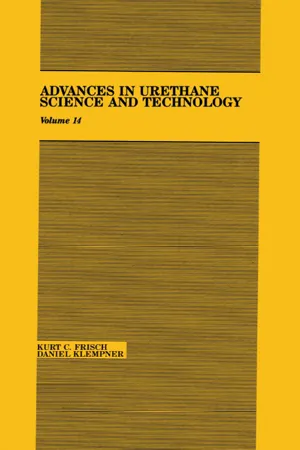
- 328 pages
- English
- ePUB (mobile friendly)
- Available on iOS & Android
About This Book
Flexible polyurenthane foams of all types are a unique group of plastics materials, characterized by the fact that a multitude of different sets of properties can be obtained by varying the levels of a relatively small number of base components in the formulations. Different foam grades, primarily characterized by density and hardness, can be obtained by changing the ratio between base polyol, polymer polyol, water, blowing agent, isocyanate and other components. It is not uncommon for foam producers in industrialized countries to manufacture more than one hundred different foam grades based on these basic chemicals, plus the ancillary chemicals needed for optimized processing. This has always made flexible polyurethane foams a highly suitable candidate for correlating these variations in the formulations with the resulting properties in a mathematical way, aimed at predicting the properties as accurately as possible, fine-tuning existing grades or designing new foam grades. This book discusses the methodology for obtaining meaningful equations for correlating properties with formulation variables and other influencing factors
Frequently asked questions
Mathematical Property Prediction Models for Flexible Polyurethane Foams
REINHART SCHIFFAUER
INTRODUCTION
METHODS FOR OBTAINING MATHEMATICAL PROPERTY PREDICTION MODELS
Data Collection and Preparation
Table of contents
- Cover
- Half Title
- Title Page
- Copyright Page
- Table of Contents
- Mathematical Property Prediction Models for Flexible Polyurethane Foams
- The Effective Diffusivity of Cyclopentane and n-Pentane in PU and PUIR Foams by Thin-Slice Gravimetric Analysis
- Scorch Inhibitors for Polyurethane Slabstock Foams
- A Novel Architecture for Electro-optic Polyurethanes: Alternating Charge Transporting and Nonlinear Optical Chromophores
- Advances in Moisture-Curable Siloxane-Urethane Polymers
- New Synthetic Pathways to Polyether Polyols for Rigid Polyurethane Foams
- PU Based Structural RIM Composites for a Complete Car Floor Pan
- Effect of Crosslink Variation on Physical Properties of Polyurethanes
- Structure-Property Relationships of Polyurethane Elastomers Based on New Saturated Hydrocarbon Diols
- Polyurethane Elastomers Based on Novel Hydrocarbon-Based Diols
- Polyurethane Structural Adhesives for Automotive Applications